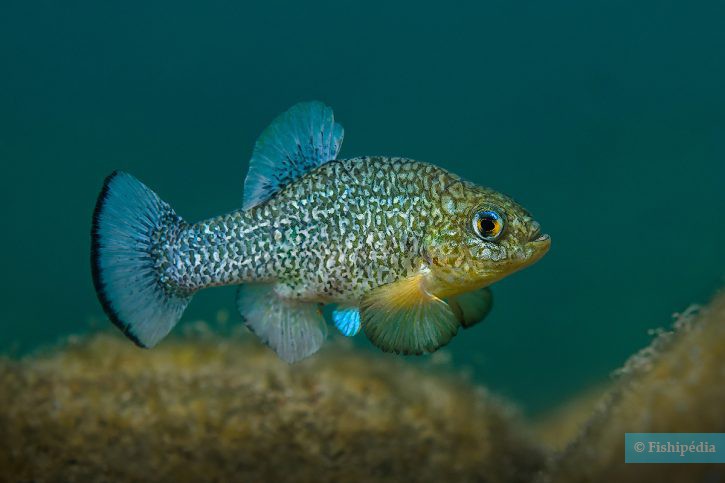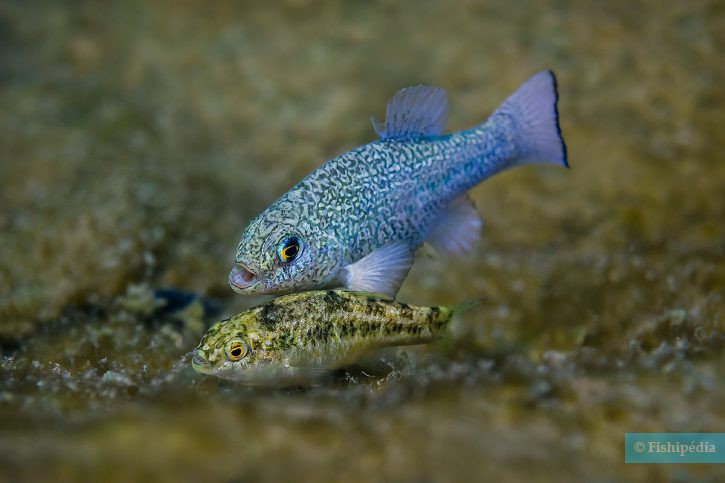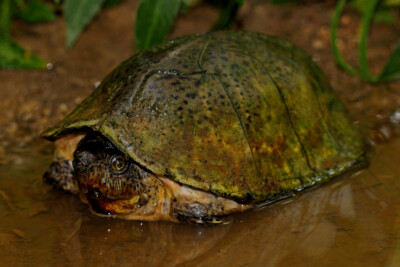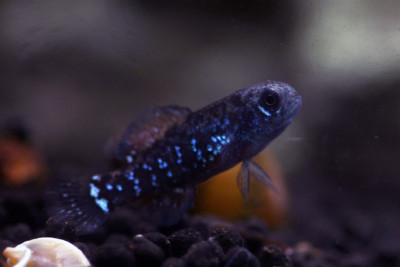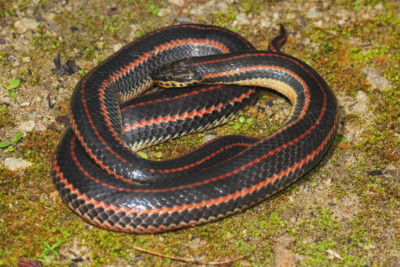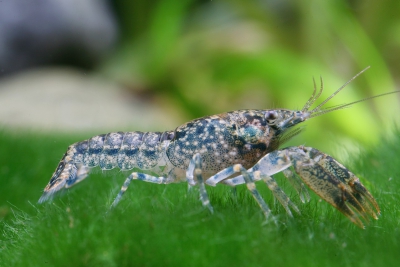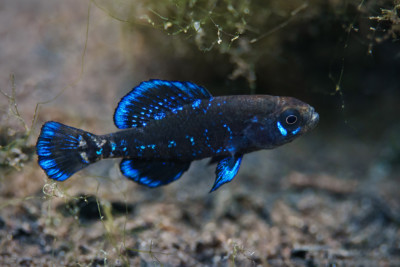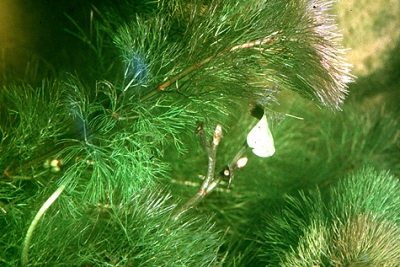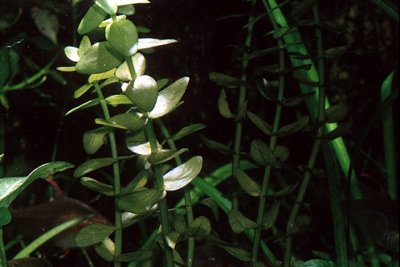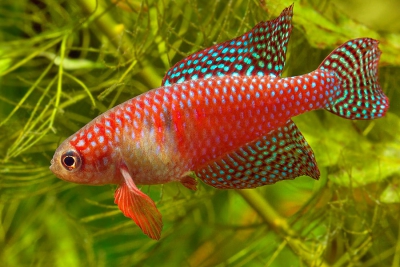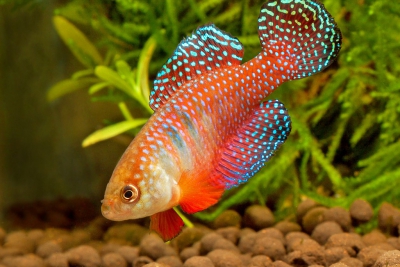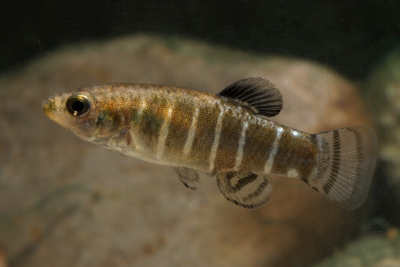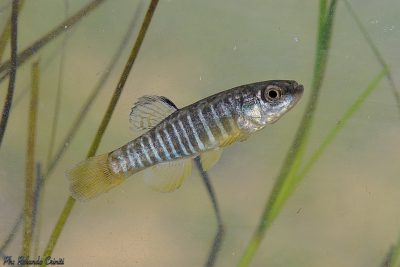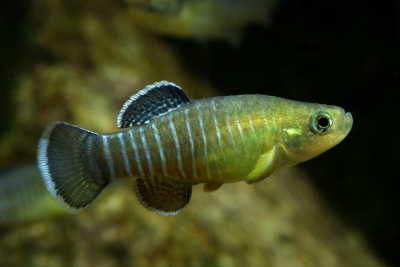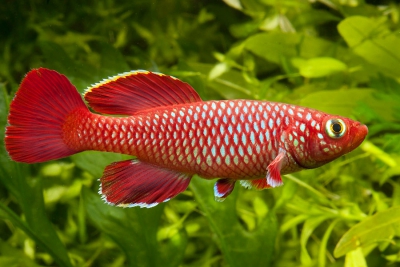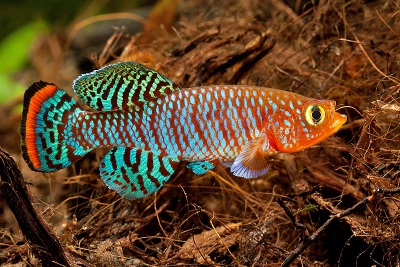comanche springs pupfish
| Scientific name | Cyprinodon elegans |
|---|---|
| Descriptor | Baird & Girard |
| Year of description | 1853 |
| IUCN category (World) | EN |
| Family | Cyprinodontidae |
| Genus | Cyprinodon |
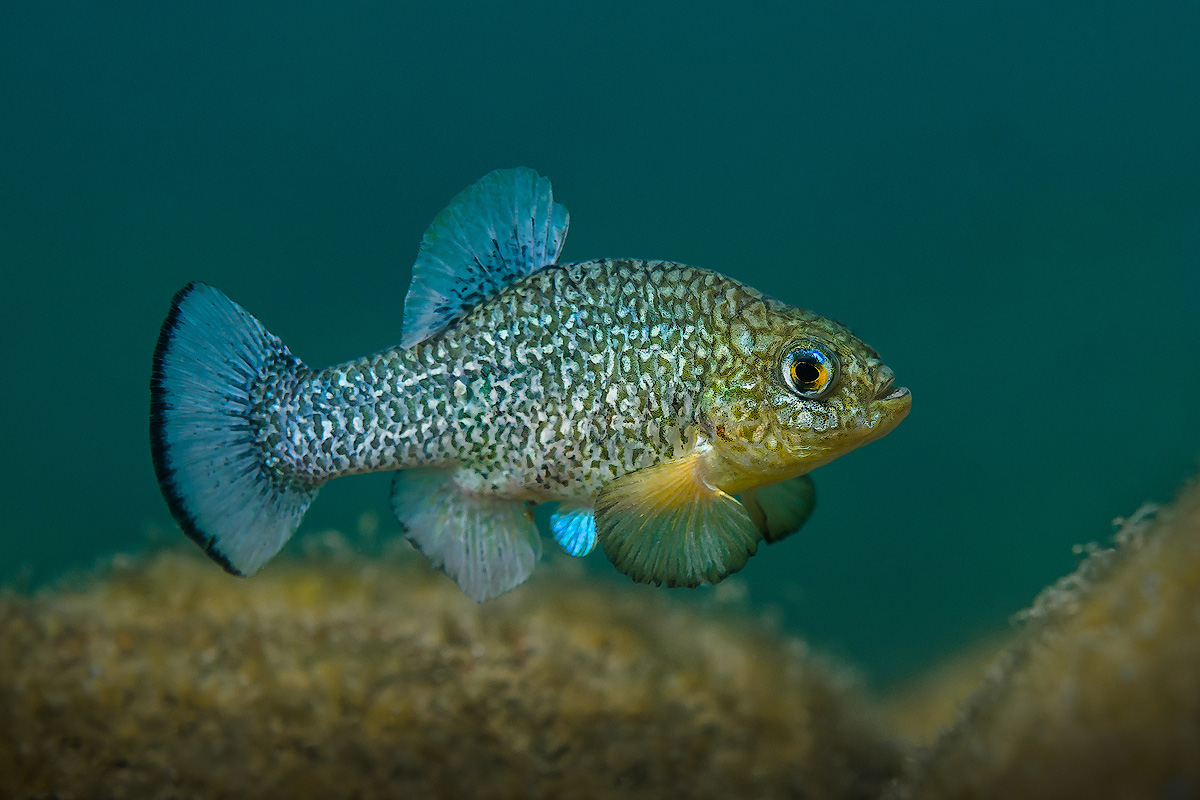

Introduction
The Comanche Springs Pupfish is a killifish that lives around Toyah Creek and San Solomon Springs, not far from the Rio Grande Basin. It is threatened by the introduction of non-native species into its small distribution range.
Its English name, "Comanche Springs Pupfish", refers to the Comanche Springs, which consist of six underground springs that originate a famous oasis. Initially, the Jumano Indians inhabited the area. Subsequently, the Apaches, Comanches, and Kiowa frequently visited it. This region was also the scene of several armed conflicts between the Plains Indians and the Americans.
Who is it?
Morphology
-
Average size4 cm
-
Maximum size5 cm
-
ShapeOval
-
Patternponctuations
-
Average size4 cm
-
Maximum size5 cm
-
ShapeOval
-
Patternponctuations
How to recognize This fish ?
The Comanche Springs Pupfish is a small killifish with a compressed body.
Sexual dimorphism
Males, which are larger in size, are in metallic blue tones while females are more beige.
Behaviour & Life cycle
-
dietcarnivorous
-
Sociabilityliving in small groups
-
territorialYes
-
Way of livingdiurnal
Dominant males, generally more massive, are territorial and remain on guard in their small area. They attack overly curious subordinates and try to mate with any nearby females.
These fish are omnivorous. Their diet includes small insects, filamentous algae, and even seeds. This diversified diet is a definite advantage for survival in their specific environment.
Reproduction
-
Reproductionovipare qui dépose ses Œufs dans la végétation
Although eggs are laid within the territories of dominant males, there is no parental protection. These sites primarily serve as a seduction area. In moving water, eggs are laid in vegetation while they are rather deposited on rocks in calm areas.
Harmless species
This species does not represent any particular threats to humans when encountered in its natural environment.
Origin and distribution
Geographic distribution & Conservation
A population is maintained near Balmoreah in Texas, especially around the "Phantom Springs Cave". The introduction of a congeneric species, Cyprinodon varieatus, is likely to threaten the populations in calm waters in the long term. The Texas Parks and Wildlife Department is considering building a refuge for this species.
Conservation status of populations (IUCN)
What is its habitat?
Natural environment characteristics
-
Temperature18 - 26 °C
-
pH (acidity)7 - 8
-
FlowMedium, Slow and Stagnant
Biotope presentation
The Comanche Springs Pupfish naturally resides in relatively alkaline water. It lives in shallow waters (less than 2 meters deep) in areas with high presence of vegetation (aquatic and marsh plants, decomposing organic matter, branches...).
It lives in well-oxygenated waters but is not exclusive to any specific biotope. It is found in calm areas as well as in currents.
Species of the same biotope
Main recommendations for fishkeeping
Deontology
In order to preserve wildlife, if you acquire this animal, it must not be released into the wild. See also, the Fishipedia charter.
Fishipedia supports the practice of responsible and environmentally friendly aquarium keeping. We encourage maintenance if it is motivated by a desire to understand the biological functioning of living things and if it is done with respect for animal life.
We believe that aquaristics is an opening to the discovery of aquatic environments, especially freshwater, and that this knowledge is necessary to better protect and respect these environments. Logically, we refute the compulsive purchase of animals that would not find a sufficient and / or adapted place in the host aquarium.
Our recommendationsThese tips apply to adult species from breeding. With regards to water conditions, wild species or close relatives must be kept under the same conditions as in their area of origin.
-
Min volume40 liters
-
Population min2
-
Temperature18 - 26 °C
-
pH (acidity)7 - 8
CharacteristicsThe characteristics below apply for adult species. They correspond to an average of cases, validated in maintenance condition.
-
Difficulty breedingThe farming difficulty is relative. It depends on experiments already carried out with similar species. First, it takes into consideration the robustness of the species, the ease of recreation of a favorable environment and the general behaviour with the other inhabitants of the aquarium.hard
-
Robustnessrobust
-
Behaviourmoderately aggressive
-
Availabilityunavailable
Recommended equipment from our partners
-
Aquarium
-
Filtration
General reminders
It is strongly advised to read the complete dedicated file and to get information on the feedbacks of maintenance of the envisaged animal, this to avoid any potential conflict whose end result is generally the death of the individual (or the other inhabitants). It is important not to overload your aquarium to limit pollution. This will make maintenance easier.
In nature, animals are subject to weather conditions and live in waters with variable characteristics. The recommendations offered by our team for aquarium maintenance are a guidance and cannot be assimilated to scientific datas.
General reminder on maintenance datas
Le démarrage d'un aquarium est une partie primordiale pour l'équilibre et le bien-être des poissons. Lorsque l'on met en eau un aquarium, l'eau passe naturellement par un cycle biologique : le cycle de l'azote. Celui-ci dure environ trois semaines. Tous les 2 jours, nous vous conseillons de tester votre eau jusqu'à ce que le taux de nitrite soit à zéro pendant plusieurs jours d'affilée.
Pour accélérer ce cycle, vous pouvez utiliser un activateur de bactéries comme JBL Denitrol. Cette solution riche en bactéries vivantes et enzymes permet une mise en place rapide du cycle de l'azote. Les poissons peuvent alors être introduits plus rapidement.
Il est important de tester l'eau de son aquarium régulièrement pour maintenir un environnement sain pour les poissons et les autres habitants. Les tests d'eau permettent de mesurer les niveaux de différents paramètres tels que le pH, la dureté totale, ainsi que les taux de nitrates, de nitrites et d'ammoniaque.
Pour réaliser ces tests, vous pouvez utiliser des produits d'analyse spécialisés tels que JBL ProScan qui permet de réaliser un diagnostic de l'eau directement via un smartphone. Il existe également des coffrets de tests plus classiques de bandelettes, comme JBL PROAQUATEST.
En cas d’usage de l’eau du robinet, vous pouvez utiliser un conditionneur d’eau de type Biotopol de JBL pour éliminer les substances nocives comme le chlore, le cuivre, le plomb et le zinc. Les conditionneurs d'eau garantissent une meilleure santé aux poissons et une meilleure croissance des plantes.
Chlorine and chloramine are dangerous for the health of animals. Used to disinfect water, these agents are present in significant quantities in tap water. We recommend using an anti-chlorine agent every time you change the water. In addition to chlorine, treatments and medicines sold for aquarium use sometimes contain dangerous heavy metals in high doses.
Specific needs for the comanche springs pupfish
The comanche springs pupfish is a species which lives naturally at a temperature between 18 °C and 26 °C. For proper maintenance, the temperature should never exceed the 29°C for long periods. Nitrate levels should remain below 50mg/L. To keep the water clean and unpolluted, plan on changing 20% to 30% of the water volume each month.
The comanche springs pupfish is a species whose maintenance is rather reserved for informed aquarists . It can only be successfully carried out by carrying out a minimum of documentation work. Special husbandry conditions can easily lead to the death of the species.
Jumping fish
Be careful, the comanche springs pupfish is an excellent jumper, naturally using this faculty to change its living area or to escape from predators. The aquarium must be perfectly covered to prevent him from making a deadly jump...
Cohabitation & Environment
The comanche springs pupfish is a fish which it is advisable to maintain in specific aquarium. Associating it with other species is not fundamentally impossible but a documentation work is necessary for the constitution of the population. Being a living in small groups fish, it is advisable to install at least 2 individuals in an aquarium of 40 liters minimum. Group maintenance is a prerequisite to ensure their well-being. Lonely individuals tend to quickly become stressed and become especially susceptible to disease.
Males have the particularity to be particularly oppressive with females. This behavior can tire the females to the point that it sometimes leads to their death. It is important to set up a planted aquarium with many refuges.
It should be noticed that this species should not be kept with large crustaceans or fish, as it would become a prey of choice. Smaller species should preferably be inserted in the aquarium some time before the larger ones. Moreover, if you want to breed it, it is better to put them in a specific aquarium.The species enjoys a particularly vegetation-rich environment. The addition of plants will provide many useful hiding places for resting. These areas are also conducive to possible breeding in the aquarium.
Tips for feeding
The comanche springs pupfish is carnivorous.
This species can eat dry food (flakes, pellets), fresh food and frozen food. To avoid deficiencies, it is recommended to vary the types of food.
You should not overfeed your residents to avoid polluting the water. For most species, it is better to feed a few small portions each day rather than one large meal.
Food recommendations from our partner JBL - Products PRONOVO
-
Granules
-
Flakes
-
Sticks
Reproduction protocol
-
egg-laying protectionNo
Hybridization risks
In general, it is advised not to mix several species of the same genus or different varieties of the same species, to avoid the risks of hybridization.
These plants might interest you
Plants play a crucial role in aquariums, both for their ability to filter water by absorbing excess nutrients and for their aesthetic contribution. They provide fish with natural hiding places, can serve as breeding sites, and generally help maintain the overall balance and optimal conditions of the aquarium. The selection presented here includes species from the same regions as the species described on this page, although they do not necessarily come from its exact natural biotope.
To go further
Sources & Contributions
Participation & Validation
The Fishipedia team and specialist contributors are committed to providing high-quality content. However, although the information comes from scientific sources or testimonials from specialists, the cards may contain inaccuracies.

Benoit Chartrer
Translation
Translation done with the valuable contribution of our translators, who make this information available to a wider audience. We sincerely thank them for their commitment.
Bibliographic references
A Field Guide to Freshwater Fishes of North America North of Mexico - Brooks M. Burr - Lawrence M. Page - Copeia - 1992. Review by: Richard L. Mayden
AN OUTLINE OF THE GENUS CYPRINODON - Estella Flather - Copeia - 0. Review by: Richard L. Mayden
REPRODUCTIVE SUCCESS AND THE EVOLUTION OF BREEDING TERRITORIES IN PUPFISH (CYPRINODON) - Astrid Kodric‐Brown - EVOLUTION - 1977. Review by: Richard L. Mayden
Scientific partners
Species of the same family
Species of the same biotope
